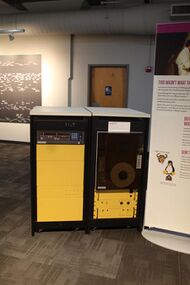Company:Interdata
| Industry | Technology |
|---|---|
| Fate | Purchased by Perkin-Elmer and later known as Concurrent Computer Corporation |
| Founded | 1966 |
| Headquarters | Oceanport, New Jersey |
Key people | Daniel Sinnott |
| Products | Interdata 7/32 |

Interdata, Inc., was a computer company, founded in 1966 by a former Electronic Associates engineer, Daniel Sinnott, and was based in Oceanport, New Jersey. The company produced a line of 16- and 32-bit minicomputers that were loosely based on the IBM 360 instruction set architecture but at a cheaper price.[2] In 1974, it produced one of the first 32-bit minicomputers,[3] the Interdata 7/32. The company then used the parallel processing approach, which uses more than one computer processor simultaneously to perform work on a problem. This helped in making real-time computing a reality.[4][5]
Some real-time applications Interdata computers were used for included: Core Protection Calculator, used in some later Combustion Engineering designed nuclear power plants; lottery systems manufactured by GTech; the NexRad weather radar system. Many companies used them for internal high speed laboratory data capture, such as United Technologies Research Center in East Hartford, Connecticut wind tunnel, General Electric R&D in Schenectady, New York, and Perkin-Elmer in Connecticut (which later acquired Interdata).
The operating system for the 16-bit computers was called OS/16, and for the 32-bit computers OS/32. The assembly language could generate series independent object code. Later, as with Gould, SEL, Modcomp and other real time competitors, they offered a 32-bit time sharing system called MTM (Mutli Terminal Monitor).
Acquisitions
In 1973, it was purchased by Perkin-Elmer Corporation,[6] a Connecticut-based producer of scientific instruments for $63.6 million.[4] Interdata was already making $19 million in annual sales but this merger made Perkin-Elmer's annual sales rise to over $200 million.[4] Interdata then became the basis for Perkin-Elmer's Data Systems Group.[7] In 1985, the computing division of Perkin-Elmer was spun off as Concurrent Computer Corporation.[8]
List of products
- Interdata Model 1 – 1970[9]
- Interdata Model 3 – 1967[10][11]
- Interdata 4 (autoload, floating point)
- Interdata 5 (list processing, microcoded automatic I/O channel)
- Interdata 70 (1971), 74 (1973), 80 (1971), 85 (Writable Control Store, 1973)[9]
- Interdata 50, 55 (Communications systems)
- Interdata 5/16, 6/16, 7/16 (1974)[9]
- Interdata 8/16, 8/16e (double precision floating point, extended memory)
- Interdata RD-800 and RD-850 – 1975[9]
- Interdata 7/32 – 1974[9]
- Interdata 8/32 – 1975[9]
- Perkin-Elmer 3205, 3210, 3220, 3230, 3240, 3250, 3280
A simulator is available: http://simh.trailing-edge.com/interdata.html
References
- ↑ "Concurrent will sell building". Asbury Park Press: pp. C1, C3. October 9, 1996. https://www.newspapers.com/clip/102629496/asbury-park-press/.
- ↑ "Interdata Reference Manual 29-004R02 – Computing History". http://www.computinghistory.org.uk/det/28934/Interdata-Reference-Manual-29-004R02/. Retrieved 27 July 2016.
- ↑ "About Concurrent – Concurrent". https://www.concurrent.com/about/about-concurrent/. Retrieved 27 July 2016.
- ↑ 4.0 4.1 4.2 "Concurrent Computer Corporation – FREE Concurrent Computer Corporation information | Encyclopedia.com: Find Concurrent Computer Corporation research". http://www.encyclopedia.com/doc/1G2-3445200037.html. Retrieved 27 July 2016.
- ↑ "Parallel Processing". Enclicopedia.com. https://www.encyclopedia.com/science-and-technology/computers-and-electrical-engineering/computers-and-computing/parallel-processing.
- ↑ Enterprise, I. D. G. (1990-12-10) (in en). Computerworld. IDG Enterprise. https://books.google.com/books?id=xADOH_NYfZoC&q=concurrent+computer+corporation+history+and+interdata&pg=PA103. Retrieved 27 July 2016.
- ↑ Trew, Arthur; Wilson, Greg (2012-12-06) (in en). Past, Present, Parallel: A Survey of Available Parallel Computer Systems. Springer Science & Business Media. ISBN 9781447118428. https://books.google.com/books?id=HZzeBwAAQBAJ&q=concurrent+computer+corporation+history+and+interdata&pg=PA76. Retrieved 27 July 2016.
- ↑ "Concurrent Computer Corporation". http://www.new-npac.org/projects/cdroms/cewes-1999-06-vol1/nhse/hpccsurvey/orgs/concurrent/concurrent.html. Retrieved 27 July 2016.
- ↑ 9.0 9.1 9.2 9.3 9.4 9.5 Auerbach Guide to Minicomputers 1975. Auerbach. 1975. p. 5 (12). https://archive.org/details/bitsavers_auerbachAumputers1975_31095575.
- ↑ "Interdata Model 2, 3 and 4". Computers and Automation 16 (12): 3 (ad), 31 (Model 2), 36 (Model 4), 71 (Model 3). Dec 1967. https://archive.org/details/bitsavers_computersA_11280381.
- ↑ "Across the Editor's Desk: LOW-COST COMPUTER FOR ENGINEERING AND LAB RESEARCH". Computers and Automation 16 (9): 45. Sep 1967. https://archive.org/details/bitsavers_computersA_7896122.
External links
- interdata.org.uk – Site detailing the restoration of an Interdata Model 74 computer
- http://www.computinghistory.org.uk/det/28933/Interdata-Model-70-Users-Manual/ Model-70 User's Manual
- "Interdata computers documents". http://www.bitsavers.org/pdf/interdata/.
 |


